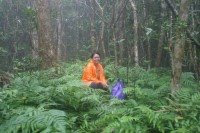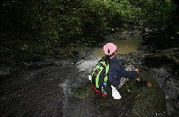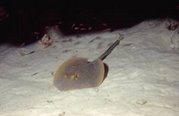
From Treasures, the inflight magazine of Asian Spirit
When I was young I dreamt of an island where swaying coconut trees tower against bright blue sky, where the surrounding water is emerald green and where white sandy beaches glimmer in the sun. For years this vision became my definition of the “perfect” island.
Eighteen years ago I bravely ventured into frontier territory, the Palaui Island Protected Landscape and Seascape and discovered a paradise that has all the elements I dreamt of and much more. It turned out to be an island dotted with coralline beaches, tall forest trees, seagrass meadows, mangroves, cliffs, tidal pools, springs, waterfalls, rock formations, islets and even a centuries-old Spanish lighthouse.
Being involved in the crafting of a community-based sustainable tourism project for Palaui Island, I have to travel to Cagayan almost every month. The project aims to ensure that all its natural and cultural heritage will remain for many generations. This is a very fitting goal for an island that has remained well preserved and this is partly due to the inclusion of the municipality of Sta. Ana into the 54,000 hectare, Cagayan Special Economic Zone and Freeport. The area which is being developed and managed by the Cagayan Economic Zone Authority (CEZA) also covers three other islands of the municipality of Aparri, namely Fuga, Mabbag and Barit. CEZA recognizes the great potential for tourism development and the benefits it could bring. Palaui Island, because of its pristine condition and many attributes, has been identified as a priority site and thus in March 2006 the Community-based Sustainable Tourism project was launched.
By land it normally takes ten hours from Manila to Tuguegarao and from there it is another 2 ½ hours to the town of Sta. Ana, the jump off point for Palaui Island. This year, Asian Spirit started having chartered flights twice a week from Manila to Macau via Tuguegarao City and flying drastically cuts down the travelling time. I had great anticipation for a trip back to the island as I fastened my seatbelt on board tha aircraft. The flight was brisk and only took 45 minutes.
From the San Vicente fish port I took a boat to visit an island unlike any other. Called Palami in old Spanish documents, the island is an emerging destination for outdoor adventure sports and most of it is frontier territory. It is located in the municipality of Sta. Ana, along the periphery of one of the most treacherous body of water in the Philippines, the Babuyan Channel.

Nature’s wild creation
I have traveled to many remote locations in the country. I can endure the inconveniences of getting to far-flung places because I extremely enjoy experiencing the rawness of nature. It is almost always worth the time and effort. One important lesson I learned is that the more inaccessible a place is the more preserved it is. Palaui Island however has defied this rule. It is very accessible and yet it has well preserved terrestrial and marine ecosystems in place.
The protected area spans 7,415.48 hectares and includes primary and secondary forests, mangroves, caves, grassland, coral reefs, inter-tidal zones, seagrass meadows, geologic formations, small islets and a community of a little over 500 people. Forest cover is nearly 80 percent of the land area. Its forests serve as habitat for many threatened and near-threatened species of wildlife including the dwarf king fisher, rufous paradise flycatcher, serpent eagle and the tarictic hornbill. Resource inventories conducted by Conservation International and the University of the Philippines Institute of Biology show that the biodiversity of flora is very high, considering the size of the island.
The island's seascapes exudes breathtaking sceneries. The submarine cliffs, shallow coral gardens, caverns, crevices and canyons provide niches for a wide variety of marine life. From the tiny nudibranch to turtles and whales, the domain beneath the surface of the water is also teeming with life. An underwater survey conducted in 2005 showed potential for recreational diving, underwater photography and even for research. Divers who conducted the survey were amazed at the variety of marine species. Some even claim to have seen species of marine sea slugs and snails that they have never seen anywhere else.
Tourism that protects
Being a protected area Palaui Island needs to be preserved. The law alone will not ensure that it will remain as it is for many years. Hence, island dwellers need to be capacitated to use the resources wisely and to engage in livelihood that are non-extractive. The potential of Palaui for environmental education and nature tourism is very clear. The community recognizes this and they have committed themselves to be stewards of this precious island. They have organized themselves into a group called Palaui Environmental Protectors Association (PEPA). CEZA had been providing technical assistance through training and enterprise development in order to increase their capability to improve their lives.
Tourism consultant Louie Mencias says that community involvement and capacity building are essential towards making tourism and nature conservation work, not just for Palaui but for other protected areas of the country.
“CEZA plans to build an ecolodge on the island that will comply with international standards. The community will be a partner in this initiative,” adds Mencias.
Bantay Kalikasan is a small group of volunteers that monitors and reports to authorities possible illegal activities on and around the island. The members double up as guides who ensure that visitors follow protected area protocols, deepen their understanding of nature, ecology, culture and history through indigenous knowledge interpretation, and have meaningful experiences as they hike the trails or cruise around the island.

Lighthouse restoration
On top of a hill 92.75 meters high, is the preserved centuries-old lighthouse of Palaui Island. It will soon be declared by the National Museum as an important cultural property. Designed by Engr. Magin Pers y Pers, construction started in 1887 but it was not completed until Dec. 30, 1892. The ravaging of time and of the natural elements has taken its toll and the lighthouse is in need of rehabilitation. With this concern, CEZA has established a partnership with the Department of Transportation and Communications, National Museum, National Historical Institute, National Commission on Culture and Arts and the municipality of Sta. Ana and the provincial government of Cagayan in order to take the necessary steps to save this built heritage. The Faro de Cabo Engaño is the northern-most Spanish lighthouse in the country and is in fact featured in the book “Spanish Lighthouses of the Philippine” by Manuel Noche.
“It is part of the Filipino heritage and we need to save it so that other people and future generations will appreciate its history,” says Sec. Jose Mari B. Ponce, CEZA Administrator and CEO.
In order to promote the island, CEZA has been organizing its yearly summer Aquathlon where top triathletes in the country compete.

As the island is being positioned as a place for authentic learning, visitors will soon be treated to an inspiring and highly educational experience that will promote responsible travel. Indeed heritage and biodiversity conservation , as well as sustainable tourism are important initiatives that will be integrated in the General Management Plan of Palaui Island. This only highlights the need to protect not only biodiversity, but also culture and history through sustainable tourism. This approach will certainly ensure that Palaui becomes a destination that will last for many generations.







No comments:
Post a Comment